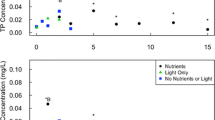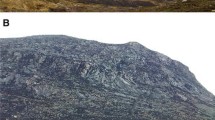Abstract
The frequency of fires in the Okavango Delta seasonal floodplains peaked at an intermediate frequency of flooding. Floodplains are commonly burnt every 3–5 years. This study showed fundamental changes in ecosystem properties due to burning. A burnt seasonal floodplain in the aquatic phase had oxygen levels well above saturation, 100–200%, while the levels in the un-burnt control site were below saturation and, at night, could decline to 10–40% saturation. The total phosphorous and total nitrogen concentrations were similar on both floodplains but considerably enriched relative to inflowing water, due to nutrient release from the flooded soil-sediment and animal droppings. Zooplankton biomass was very high in both systems although the abundance of fish fry was ten times higher on the un-burnt floodplain. In a low flood year the un-burnt floodplain water had high nutrient levels, primary production, methane emission, and subsequent uptake of methane in biota, as well as a high zooplankton biomass. The very high flood the following year showed the opposite with much lower production at all levels owing primarily to greater dilution of nutrients. The abundance of fish, however, was much higher during the high flood year. Macrophytes and litter provide direct shelter for fish fry but also promote low oxygen levels when decaying. Large flooded areas result in high fish production by removing obstacles related to congestion. This interplay between hydroperiod and fire may be crucial for the maintenance of high biological productivity both in the aquatic and terrestrial phases in a very nutrient poor wetland landscape. Understanding these interactions is crucial for optimal management.




Similar content being viewed by others
References
Bonyongo MC (1999) Vegetation ecology of the seasonal floodplains in the Okavango Delta, Botswana. Dissertation, University of Pretoria, South Africa
Bonyongo MC, Bredenkamp GJ, Veenendaal E (2000) Floodplain vegetation in the Nxaraga Lagoon area, Okavango Delta, Botswana. S Afr J Bot 66(1):15–21
Connell JH (1978) Diversity in tropical forests and coral reefs. Science 199:1302–1310
Cronberg GA, Gieske A, Martins E, Prince-Nengu J, Stenstrom I (1996) Major ion chemistry, plankton, and bacterial assemblages of the Jao/Boro River, Okavango Delta, Botswana: the swamps and flood plains. Archiv für Hydrobiologie, Supplement b and Monographische Beiträge. ISSN 0341-2881 3:335–407
DeBano LF, Neary DG, Ffolliott PF (1998) Fire’s effects on ecosystems. Wiley, New York
Heinl M, Neuenschwander A, Sliva J, Vanderpost C (2006) Interactions between fire and flooding in a southern African floodplain system (Okavango Delta, Botswana). Landsc Ecol 21:699–709
Heinl M, Frost P, Vanderpost C, Sliva J (2007) Fire activity on dryland and floodplains in the southern Okavango Delta, Botswana. J Arid Environ 68:77–87
Hilborn R, Walters CJ (1992) Quantitative fisheries stock assessment: choice, dynamics and uncertainty. Chapman and Hall, New York
Høberg P, Lindholm M, Ramberg L, Hessen DO (2002) Aquatic food web dynamics on a floodplain in the Okavango Delta, Botswana. Hydrobiologia 470:23–30
Ishida S, Nakashizuka T, Gonda Y, Kamitani T (2008) Effects of flooding and artificial burning disturbances on plant species composition in a downstream riverside floodplain. Ecol Res 23:745–755
Junk WJ, Bayley PB, Sparks RE (1989) The flood pulse concept in river-floodplain systems. In Dodge DP (ed) Proceedings of the international Large River Symposium. J Can Fish Aquat Sci 106:110–127
Kolding J (1993) Population dynamics and life-history styles of Nile tilapia, Oreochromis niloticus, in Ferguson Gulf, Lake Turkana, Kenya. Environ Biol Fishes 37:25–46
Lindholm M (2006) Zooplankton diversity and successions in the Okavango Delta, Botswana, diversity and ecosystem interactions in land/water ecotones. Dissertation, University of Oslo, Norway
Lindholm M, Hessen DO (2007) Zooplankton succession on seasonal floodplains: surfing on a wave of food. Hydrobiologia 592(1):95–104
Lindholm M, Hessen DO, Mosepele K, Wolski P, Ramberg L (2007) Food webs and energy fluxes on a seasonal floodplain: the influence of flood size. Wetlands 27:775–784
Lindholm M, Hessen DO, Ramberg L (2009) Diversity, dispersal and disturbance: cladoceran species composition in the Okavango Delta. Afr Zool 44(1):24–35
Meyer T (1999) Ecological mappings in the research area of the Harry Oppenheimer Okavango Research Centre, Okavango Delta, Botswana. Dissertation, Hochschule Anhalt, Bernburg, Germany
Mitsch WJ, Gosselink JG (2007) Wetlands, 4th edn. Wiley, New York
Mladenov N, McKnight DM, Wolski P, Murray-Hudson M (2007) Simulation of DOM fluxes in a seasonal floodplain of the Okavango Delta, Botswana. Ecol Model 205:181–195
Mubyana T, Krah M, Totolo O, Bonyongo CM (2003) Influence of seasonal flooding on soil total nitrogen, organic phosphorous and microbial populations in the Okavango Delta, Botswana. J Arid Environ 54:359–369
Noe GB, Hupp CR (2007) Seasonal variation in nutrient retention during inundation of a short-hydroperiod floodplain. River Res Appl 23:1088–1101
Ogden R, Reid M, Thomas M (2007) Soil fertility in a large dryland floodplain: patterns, processes and the implications of water development. Catena 70:114–126
Pearsall WH, Mortimer CH (1939) Oxidation–reduction potentials in waterlogged soils, natural waters and muds. J Ecol 27:483–501
Ramberg L, Wolski P, Krah M (2006) Water balance and infiltration in a seasonal floodplain in the Okavango Delta, Botswana. Wetlands 26:677–690
Rutz D (2004) The influence of fire on site productivity in southern Africa (study site: Okavango Delta, Botswana). Dissertation, Technische Universitat Munich, Germany
Welcomme RL (1979) The inland fisheries of Africa. Committee for inland fisheries of Africa occasional paper no. 7. FAO/UNDP, Rome
Wetzel RG (2001) Limnology, lake and river ecosystems. Elsevier, San Diego
Acknowledgments
This study was partially funded by Grant no. 154410/720 from the Norwegian Research Council, and partially by the University of Botswana.
Author information
Authors and Affiliations
Corresponding author
Rights and permissions
About this article
Cite this article
Ramberg, L., Lindholm, M., Hessen, D.O. et al. Aquatic ecosystem responses to fire and flood size in the Okavango Delta: observations from the seasonal floodplains. Wetlands Ecol Manage 18, 587–595 (2010). https://doi.org/10.1007/s11273-010-9195-x
Received:
Accepted:
Published:
Issue Date:
DOI: https://doi.org/10.1007/s11273-010-9195-x




